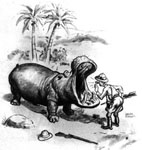
The Intense Light of the Desert & The Stark Truth About Life
JUDEA IS MORE LIKE NEW MEXICO THAN MARYLAND
New Mexico is so alien to Easterners like me that it looks, not like another state or county, but another world. The air is too clear, the sky is too blue, the mountains and rocks rarely softened by vegetation. Bill Watterson of the Calvin and Hobbes cartoon strip based his otherwordly landscapes in the Spaceman Spiff episodes on New Mexico. Nature is an abstractionist in New Mexico, and this abstract quality gives the landscape the spiritual quality found in the similar backgrounds of Byzantine icons. Not-like-this-world evokes the otherworldly. Desert dwellers see things in their essentials, because a handful of water is precious and little stands between man and both the forces of nature and the forces behind nature.
Three cultures coexist and to some extent blend in New Mexico: the Anglo, the Hispanic, and the Indian. Hispanics and Indians have more in common with each other than they do with Anglos. Anglo culture eats at them both like an acid. I have used the unfashionable term Indians to refer to those descendants of the immigrants who came over the land bridge from Siberia many millennia ago. I would gladly use their own name for themselves, but they have none. (Native American is of course English and derived from the name of an Italian, Amerigo Vespucci. Curiously, President Clinton’s Labor Department did a survey and found that they prefer the politically incorrect term, Indian, to the politically correct term, Native American, by a margin of 49 to 37 percent. The same survey found that Hispanics prefer the older term, Hispanic, over the p.c. term Latino, by 57 to 12 percent, and blacks prefer black over African-American by 45 to 28 percent.) The Indians had no consciousness of themselves as a group — if they had united, the white man could have been sent back to Europe. There were perhaps 15,000,000 Indians in North America when Europeans started arriving, and now there are only 1,000,000 to 2,000,000, depending on how they are counted. The depopulation of New Mexico is evident from the ruins. Disease aggravated by war and forced migration caused the enormous mortality from which the Indians have never recovered.
Because of their sufferings, pre-Columbian Indians are romanticized — too often so. The human race tends to split into warring units, which scarcely recognize one another’s humanity. When the Pueblo Indians revolted against the Spanish in 1680, they had to use the Spanish language to communicate among themselves, because the languages of the various Pueblo tribes were mutually incomprehensible. The Navajos look down on the Pueblo Indians, and the Pueblo Indians have a pecking order among themselves. The Zunis, who live in a city, have breathtakingly beautiful plastic arts and dances that rival the Santa Fe Opera; they regard the other Pueblos as half-civilized. Everyone still remembers Apache raids.
The slave trade continued in New Mexico at least up to the Civil War — but it was a trade in Indians, not blacks. Moreover, tribes would raid other tribes, kill the men, and sell the women and children into slavery in Santa Fe while it was under Mexico, although Mexico had outlawed slavery. Indian slavery was not as harsh as African slavery. Hispanics seemed to have little race consciousness, and captives were often adopted into families.
You May Also Enjoy
South Africa was a “first world” country for white people (and a few others) and a “third world” country for the majority of its 30 million people.
In 1986 the Alabama legislature voted to observe the third Monday of each year in commemoration of both General Lee and Martin Luther King Jr.
Even though I agree with Lincoln on the question of free soil (at least as of 1860), I cannot help but fault him and the North for savaging the South in a total war.

